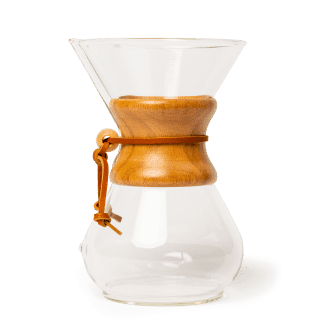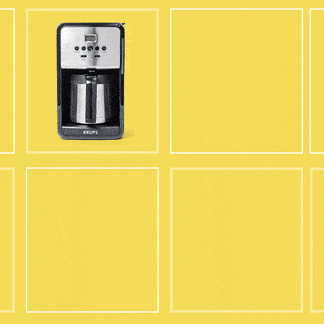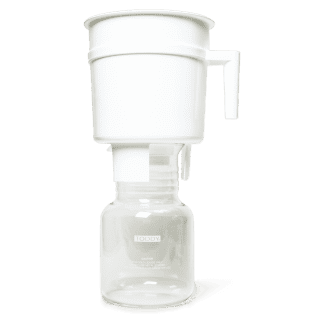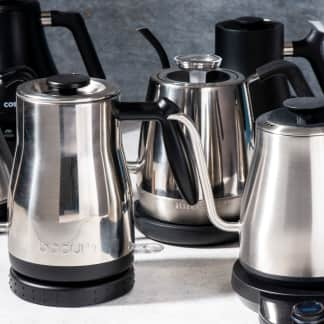Pour-over coffee makers come in a variety of styles that allow you to customize your coffee brewing experience. Flat-bottomed models are easy for novices to use and are especially good for dark-roast coffee because they highlight pleasant woodsy, cocoa-like flavors. Our favorite is the Kalita Wave Dripper 185 S. If you prefer light-roast coffee and citrusy, floral notes, we suggest using a conical model. Our favorite is the Hario V60 Ceramic Coffee Dripper 02. We also recommend the Origami Pour Over Coffee Dripper Medium as a pro-style conical option, as it produces highly rated coffee but is a bit more difficult to master.
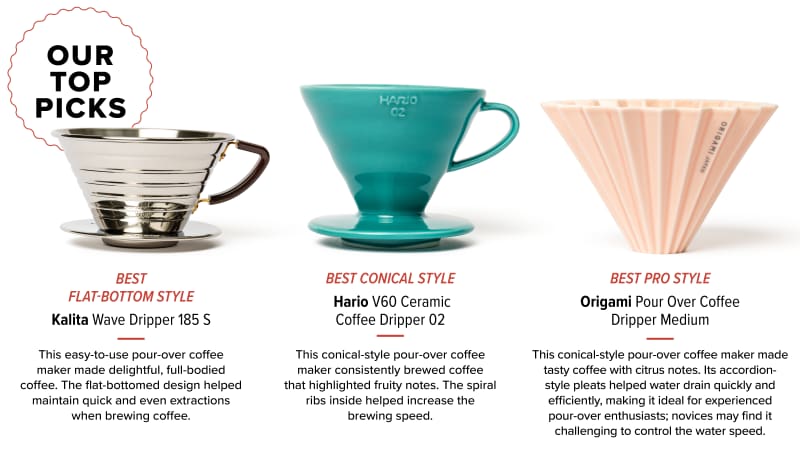
Pour-over coffee makers—also called pour-over coffee drippers—are inexpensive compared to automatic drip coffee makers and can produce coffee that’s as good or better than that made with automatic machines because you’re able to control the temperature and timing of the brew process. Most are fairly simple cuplike devices: You insert a filter, add coffee grounds, and pour in water. The coffee drips through a hole in the bottom into a mug or carafe.
Conical versus Flat-Bottomed Baskets
The two main styles of pour-over makers are conical and flat-bottomed. Conical models are shaped like a funnel, with sharply sloped walls. Flat-bottom models taper slightly to a broader, flat surface.

The Art of Pour-Over Coffee
With pour-over makers of both styles, it requires finesse to achieve optimal extraction. You insert the filter and “pre-rinse” it so it adheres to the interior walls. The prerinse also preheats the pour-over maker, reducing the chances of underextracted, sour coffee. Next you add the coffee grounds and “bloom” them with a small amount of water. During this step, the coffee grounds “degas” as carbon dioxide escapes. Finally, you steadily pour water in concentric circles from the center outwards to create an evenly hydrated “slurry” of coffee grounds and water. If the slurry is unevenly hydrated, the coffee won’t be extracted properly (see Why does my pour-over coffee taste sour and bitter at the same time?).

Models have a variety of design features intended to make the brewing process easier or more consistent. Most have ribs or ridges to encourage the flow of water through the grounds. The Chemex, a one-piece hourglass-shaped model, combines a conical pour-over cup and a carafe. Some other models have a special design that allows the water to remain inside the pour-over cup during the bloom, which allows users greater control, but otherwise work like standard pour-over coffee makers. Another has a water tank, allowing you to add all of the water at once and let it drip onto the grounds on its own. Before we got our hands on these devices, we asked ourselves: Is there a model that reigns supreme?
We tried pour-over devices in both conical and flat-bottomed designs, looking at how easy they were to use and the quality of coffee they produced. We measured coffee quality in a variety of ways. We also invited panelists to a taste test and collected feedback from testers who used the models to brew pour-over coffee at their homes. Here's what we learned from testing.
What to Look For
- Ribs or Accordion-Style Pleats: We liked models with ribs or ridges on the interior of the walls to allow water to pass through. There’s one exception that was also successful: The interior of the Chemex is smooth and doesn’t have ribs, but its proprietary filter paper works in tandem with the wide neck of the carafe, which prevents clogging.


Some models had ribs that helped water pass through more easily; one exception was the Chemex, which drained as efficiently as the ones with ribs.
- Broad, Round Openings: We liked pour-over coffee makers with broad, round openings because they allowed us to see and monitor the coffee grounds while adding water. It was easier to aim the water in the center of a round bed and move in concentric circles outward.


Pour-over coffee makers with large openings made it easy to monitor the grounds as we added water. Models with narrow openings limited our view.
- Well-Designed Drainage Holes: For both conical and flat-bottom models, hole design and placement led to more efficient draining. Our top-ranked conical model had a single ⅞-inch hole; the best flat-bottom model had three smaller (⅛ inch) holes that helped water spread out and move steadily through the grounds.
- Narrow, Round Base: We liked pour-over coffee makers with a narrow, but not too narrow, round base; we liked ones around 2⅜ inches. They fit over multiple mugs and carafes of various sizes for maximum versatility.
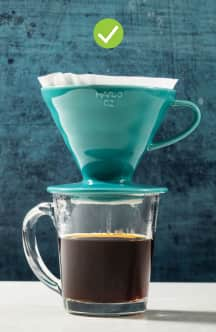
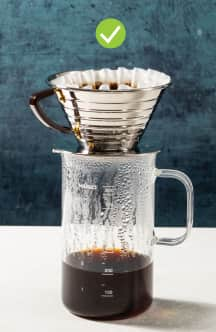

For maximum versatility, a not-too-narrow, round base is preferred.
- A Comfortable Handle: As pour-over coffee makers can get extremely hot after close-to-boiling water flows through them, a handle is helpful. We especially liked wide, semicircle handles like those common on coffee mugs.
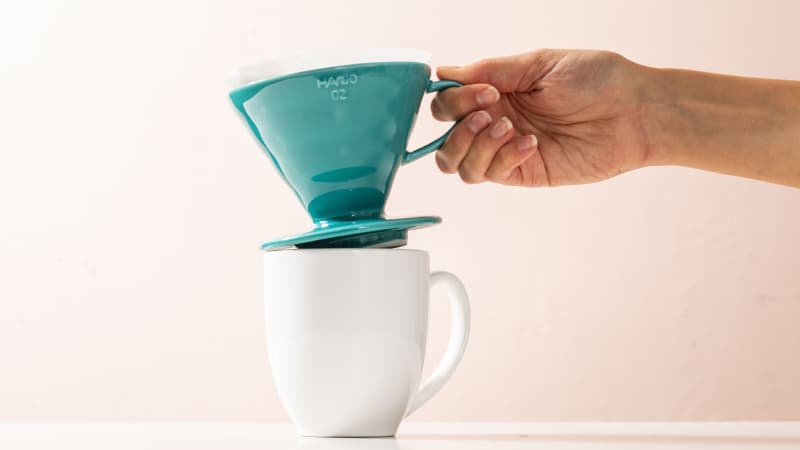
What to Avoid
- Oval or Narrow Openings: It’s harder to pour in concentric circles when you have an oval-shaped coffee bed. It’s also more likely you’ll accidentally pour water along the walls, causing it to run down the wall instead of through the coffee grounds, diluting your coffee. One device was too narrow, making it hard to monitor the water we poured over the grinds.
- Incompatible Basket Shapes: Some models weren’t compatible with widely available Melitta coffee filters or proprietary filters. When the filters didn’t adhere to the walls of the cup, they tended to collapse, blocking our view of the grounds.


When the filters aren't compatible with the pour-over coffee maker, they often collapse and block our views.
Other Considerations
- Proprietary Filters: We used widely available Melitta-branded filters across the board; we also used each model’s proprietary filters and compared results. We recommend using proprietary filters if available. Chemex, for example, has extra-thick filters that stop oils of the coffee from going through, giving the coffee a clean taste, and can support the weight of the grounds in the unique hourglass-shaped model. In other cases, proprietary filters fit the shapes of the various pour-over makers more perfectly.
- Basket Shape: The two styles determine the shape of the “coffee bed” and, in turn, how water interacts with the coffee grounds. The Specialty Coffee Association did a study with automatic machines that holds true for manual brewers as well: The two basket shapes yielded different flavor attributes. The conical shape brought out intense bitterness in dark roast but did well with light roast coffee, yielding citrus and berry notes. The flat-bottom shape was good with all roasts, highlighting flavors ranging from dried fruit in light roast to chocolate in dark roast.
- Materials: Pour-over coffee makers can be made from ceramic, glass, stainless steel, and plastic—and each material has its merits. Ceramic and glass are both durable, as long as handled with care. They aren’t fragile, but oftentimes people accidentally drop them and they break. Though less common for pour-over makers, stainless steel is lightweight, durable, and a great conductor of heat. Ceramic, glass, and stainless-steel models should all be prerinsed before adding coffee grounds. Otherwise, they can suction heat out of the coffee slurry, dropping the temperature too low and underextracting the coffee. Plastic is inexpensive and popular among professional baristas. Because plastic is lightweight, it’s less likely to suction the heat out of the coffee slurry. Though materials conduct heat differently, they can all make good coffee, making the choice of material a matter of personal preference.
The Tests
- Make pour-over coffee using light roast from Counter Culture and medium roast from Peets
- Make pour-over coffee in both small and large batches
- Make pour-over coffee with generic filters and with proprietary filters, when applicable
- Record the average flow rate of each coffee maker
- Record the Total Dissolved Solids (TDS) value of coffee made in each model using a refractometer three times and calculate the average
- Evaluate ease of use and cleanup
- Have a panel of tasters sample and rate the flavor and body of the coffee brewed with each model
- Recruit additional testers to evaluate the pour-over coffee maker in their homes
How We Rated
- Performance: We considered whether models consistently brewed batches of delicious coffee that fell within an average TDS range of 1.15 to 1.35 ppm while highlighting the unique flavor profiles.
- Ease of Use: We considered whether we could easily adhere filter paper to the interior walls so that we could load coffee grounds easily and see the grounds as we poured water over them. We noted whether the pour-over coffee makers had broad openings that allowed us to monitor the coffee bed, if they had comfortable handles, and if they were compatible with a variety of mugs and carafes.
- Cleanup: We evaluated how easy the models were to clean and noted if they had nooks or crannies that were hard to reach.




 Buy at Williams Sonoma
Buy at Williams Sonoma